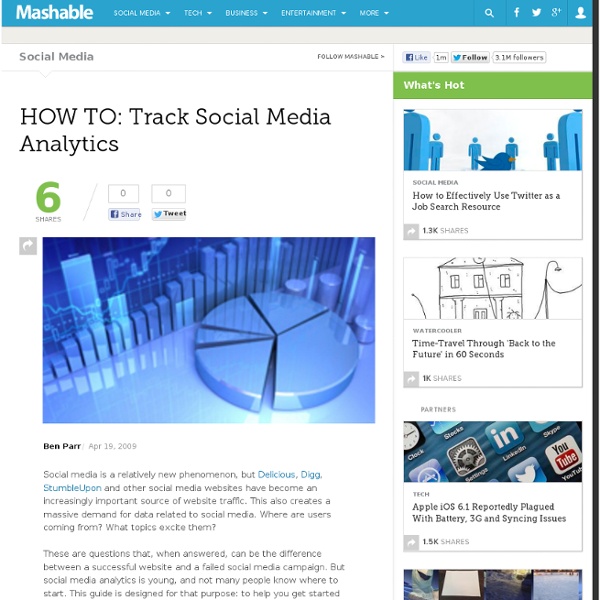Social Media Analysis
Social Media Measurement Using Google Analytics
A Klout Score for Brands? Net Promoter Creator Adapts to Social Media
Net Promoter, a mainstay of marketing measurement, is being adapted to the social media age with a Klout-like rating system based on the ratio of pro and con opinions on Twitter and Facebook. Its new product called SparkScore was announced Thursday by Satmetrix, the company that created Net Promoter. Like Net Promoter, SparkScore will rate companies on a -100-to-100 scale. Determining sentiment from social media is much trickier than the straightforward Net Promoter score, which is based on surveys. Laura Brooks, vice president of research and innovation at Satmetrix, says that Metavana will read words like "excellent" and "superior" and put them in the "promoter" category. Though company agrees that Klout is a close analog, the difference is that while Klout measures social media reach and influence via social media for individuals and brands, the SparkScore will track sentiment for brands. What do you think? Image courtesy of iStockphoto, OrangeDukeProductions
Web Analytics Consulting and Strategic Analysis Services from the Global Leader in Web Analytics Consulting | Web Analytics Consulting from Web Analytics Demystified
Stats
Want to know how many visits your site gets, and what posts and pages are most popular? Your stats page includes a bunch of nifty graphs, charts, and lists that show you all that and more. The following are not reflected in your stats: Visits to uploaded documents and filesVisits from browsers that do not execute javascript or load imagesGoogleBot and other search engine spidersVisits you make to your own publicly available blog (when logged in to your account)Visits by users that are logged in, and listed as admins on the blog You can access your stats from the Stats tab on the WordPress.com home page: or from your Dashboard: You can also access your Site Stats page via the tiny stats chart in your toolbar called a Sparkline. Views and Visitors When you visit your Stats page, you’ll see a chart which represents your traffic for the day, week, or month (depending on which filter is selected). The two main units of traffic measurement are views and unique visitors. ↑ Table of Contents ↑ Clicks
Why Social Media Monitoring Tools Are About to Get Smarter
Jim Tobin is president of Ignite Social Media, where he works work with clients including Microsoft, Intel, Nature Made, The Body Shop, Disney and more implementing social media marketing strategies. He is also author of the book Social Media is a Cocktail Party: Why You Already Know the Rules of Social Media Marketing. Over the last three years, social media marketers have gotten a lot more sophisticated about the programs they deploy and how they’re measured. Platforms like Sysomos and Radian6 have become vital tools in understanding not only the social universe in which you operate, but how that universe responds to your brand. But for all of our success, we’re still largely entering strings of Boolean variables into a tool and waiting for matching results to roll in. Cluster Analysis Shows Promise Cluster analysis is one of the features that many tools are adding. The downside to cluster analysis is that it's complex. Semantic Analysis Will Also Be Key Depth vs.
3 approches différentes des social media analytics
J’ai déjà eu l’occasion de vous parler de social scoring et des indicateurs-clés des médias sociaux que l’IAB tente de standardiser. Hasard du calendrier, ce ne sont pas deux mais trois approches différentes qui viennent d’être proposées ces derniers jours. Du très quantitatif au très qualitatif, la diversité de ces approches nous permet d’y voir un peu plus clair dans cette pratique encore méconnue. Tiens d’ailleurs, puisque j’y suis, voici comment je pourrais définir les social media analytics : “La mesure, la collecte et l’analyse de données d’usages et de comportements des internautes au sein des médias sociaux dans le but d’optimiser une stratégie ou une présence”. Approche Altimeter : Beaucoup de chiffres et d’outils La première méthodologie que je vous propose d’étudier est celle de l’Altimeter Group (dont la réputation n’est plus à faire) associé à l’auteur de Web analytics Demystified (une référence dans la profession) : Social Marketing Analytics. Approche McKinsey : Quoi ?
Twitalyzer: Serious Analytics for Social Relationships
10 Steps for Successful Social Media Monitoring
Maria Ogneva is the Director of Social Media at Attensity, a social media engagement and voice-of-customer platform that helps the social enterprise serve and collaborate with the social customer. You can follow her on Twitter at @themaria or @attensity360, or find her musings on her personal blog and her company's blog. Recently I wrote about the differences in social media monitoring and measurement, as well as the importance of doing both. However, taking the first step to actually start monitoring can be daunting. How do you engage? I've developed these throughout my career and as part of my regular listening, participating and contributing to the space. 1. Why are you monitoring? Having an end goal in mind will help you target your resources correctly, select the right tool for the job and be more effective in the end. 2. Social media is relationship and conversation media. 3. Recall that monitoring is keyword-based, and thus selection of the right keywords is important. 4. 5. 6. 7.
(16) Altimeter Report: Social Marketing Analytics



